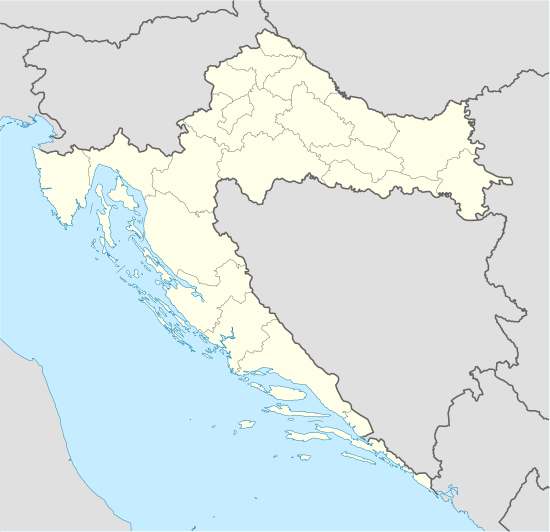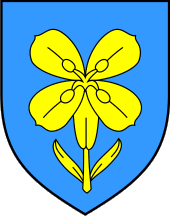Donji Lapac
Donji Lapac (Serbian Cyrillic: Доњи Лапац) is a settlement and a municipality in Lika, Croatia.
Donji Lapac | |
|---|---|
| Donji Lapac Municipality Općina Donji Lapac | |
Orthodox church of Pentecost in Donji Lapac | |
 Coat of arms | |
 Donji Lapac Location of Donji Lapac in Croatia | |
| Coordinates: 44°33′16″N 15°57′33″E | |
| Country | |
| County | Lika-Senj |
| Government | |
| • Mayor | Dušan Šijan (SDP) |
| Area | |
| • Total | 352.72 km2 (136.19 sq mi) |
| Population (2011)[3] | |
| • Total | 2,113 |
| • Density | 6.0/km2 (16/sq mi) |
| Time zone | UTC+1 (CET) |
| • Summer (DST) | UTC+2 (CEST) |
| Website | www |
Geography
Donji Lapac is located a region of eastern Lika called Ličko Pounje, by the river Una that flows near the town in the valley between mountain Plješevica and Una on the altitude of 582 m. It is connected with the road that connects Bihać with Gračac.
History
The area of Donji Lapac has been inhabited since the Iron Age, which many material remains prove. During medieval times the area of Lapac was part of old-Croatian Lapac župa, related to Lapčan family, and in 1449 it became a possession of Frankopan family. Old city Lapac was located on a nearby Obljaj hill (666 m) south from Donji Lapac. When in 1528 Ottomans conquered Lika, Lapac was absorbed.
Donji Lapac was founded in 1791, in the year the Austro-Ottoman war ended and Eastern Lika was annexed by Habsburg empire as a frontier post. In the late 19th century and early 20th century, Donji Lapac was a district capital in the Lika-Krbava County of the Kingdom of Croatia-Slavonia. In 1941 Yugoslav partisans liberated the district center.
During the Croatian War of Independence, Donji Lapac was incorporated along with other towns into the unrecognized breakaway Republic of Serbian Krajina. In August 1995, it was returned to Croatian control following victories by the Croatian army.
Demographics
According to the 2011 census, the town has population of 946 and a municipality of 2,113 people.[3] Before the war the area was almost entirely Serb-populated with only 0.67% Croats (according to the 1991 census). After the war the area of Donji Lapac municipality grew smaller because villages of Donji Srb and Gornji Srb were given to Municipality of Gračac in Zadar County. However, according to the 2011 census Serbs continue to constitute a majority of 80.6%, with 18.8% of Croat population.[4]
| Year of census | total | Serbs | Croats |
|---|---|---|---|
| 1910 | 11,971 | 10,601 (88.55%) | 1,367 (11.41%) |
| 1991 | 4,603 | 4,460 (96.89%) | 31 (0.67%) |
| 2001 | 1,880 | 1,383 (73.56%) | 471 (25.05%) |
| 2011 | 2,113 | 1,704 (80.64%) | 397 (18.79%) |
Some Croats or Serbs declared their ethnicity as Yugoslav.
Population by censuses
Municipality of Donji Lapac
According to the 2011 census, municipality of Donji Lapac had 2,113 inhabitants.[3]
| Population[5] | |||||||||||||||
|---|---|---|---|---|---|---|---|---|---|---|---|---|---|---|---|
| 1857 | 1869 | 1880 | 1890 | 1900 | 1910 | 1921 | 1931 | 1948 | 1953 | 1961 | 1971 | 1981 | 1991 | 2001 | 2011 |
| 8,553 | 10,305 | 9,481 | 10,774 | 11,691 | 11,971 | 11,529 | 11,465 | 6,641 | 6,735 | 6,456 | 5,645 | 4,845 | 4,603 | 1,880 | 2,113 |
Note: It became independent municipality in 2001 census, from old Comune of Donji Lapac.
1991 census
According to the 1991 census, Municipality of Donji Lapac had 4,603 inhabitants, which were ethnically declared as this:
| Municipality of Donji Lapac |
|---|
| 1991 |
total: 4,603 others 1 (0.02%) nondeclared 9 (0.19%) regionaly declared 1 (0.02%) unknown 15 (0.32%)
|
Austro-hungarian 1910 census
According to the 1910 census, Municipality of Donji Lapac had 11,971 inhabitants, which were linguistically and religiously declared as this:
| Population by language | Croatian or Serbian | German | Slovenian |
|---|---|---|---|
| Municipality of Donji Lapac | 11,968 (99.97%) | 2 (0.01%) | 1 (0.00%) |
| Population by religion | Eastern Orthodox | Roman Catholics |
|---|---|---|
| Municipality of Donji Lapac | 10,601 (88.55%) | 1,370 (11.44%) |
Donji Lapac (settlement itself)
According to the 2011 census, settlement of Donji Lapac had 946 inhabitants.[3]
| Population[5] | |||||||||||||||
|---|---|---|---|---|---|---|---|---|---|---|---|---|---|---|---|
| 1857 | 1869 | 1880 | 1890 | 1900 | 1910 | 1921 | 1931 | 1948 | 1953 | 1961 | 1971 | 1981 | 1991 | 2001 | 2011 |
| 1,237 | 1,475 | 1,466 | 1,142 | 1,102 | 1,140 | 1,014 | 1,008 | 667 | 726 | 1,001 | 1,286 | 1,590 | 1,791 | 812 | 946 |
Note: From 1857–1880 include data for the settlement of Gajine.
1991 census
According to the 1991 census, settlement of Donji Lapac had 1,791 inhabitants, which were ethnically declared as this:
| Donji Lapac |
|---|
| 1991 |
total: 1,791 others 1 (0.05%) nondeclared 2 (0.11%)
|
Austro-hungarian 1910 census
According to the 1910 census, settlement of Donji Lapac had 1,140 inhabitants in 2 hamlets, which were linguistically and religiously declared as this:
| Population by language | Croatian or Serbian | German | Slovenian |
|---|---|---|---|
| Donji Lapac | 1,042 | 1 | 1 |
| Lapački Zbjeg | 96 | - | - |
| Total | 1,138 (99.82%) | 1 (0.08%) | 1 (0.08%) |
| Population by religion | Eastern Orthodox | Roman Catholics |
|---|---|---|
| Donji Lapac | 936 | 108 |
| Lapački Zbjeg | 78 | 18 |
| Total | 1,014 (88.94%) | 126 (11.05%) |
Economy
Donji Lapac is underdeveloped municipality which is statistically classified as the First Category Area of Special State Concern by the Government of Croatia.[6] Before the war, Donji Lapac had a developed wood and textile industry. Many people worked in the transportation company Likatrans which employed more than 200 people. Today most of the inhabitants are unemployed and jobs are mostly restricted to public services or the renewed wood industry. Additionally many people work in basic agriculture, growing mostly potatoes and plums from which they make the alcohol Slivovitz.
Settlements in municipality of Donji Lapac
Notable people
- Milan Đukić, Croatian Serb politician
- Veljko Narančić, Yugoslav athlete
- Stevo Krnjajić, Yugoslav actor
Literature
- Savezni zavod za statistiku i evidenciju FNRJ i SFRJ, popis stanovništva 1948, 1953, 1961, 1971, 1981. i 1991. godine.
- Knjiga: "Narodnosni i vjerski sastav stanovništva Hrvatske, 1880–1991: po naseljima, autor: Jakov Gelo, izdavač: Državni zavod za statistiku Republike Hrvatske, 1998., ISBN 953-6667-07-X, ISBN 978-953-6667-07-9;
References
- Government of Croatia (October 2013). "Peto izvješće Republike Hrvatske o primjeni Europske povelje o regionalnim ili manjinskim jezicima" (PDF) (in Croatian). Council of Europe. p. 36. Retrieved 30 November 2016.
- "Općine na područjima posebne državne skrbi Republike Hrvatske" (PDF). Croatian Chamber of Economy. Retrieved 18 April 2020.
- "Population by Age and Sex, by Settlements, 2011 Census: Donji Lapac". Census of Population, Households and Dwellings 2011. Zagreb: Croatian Bureau of Statistics. December 2012.
- "Population by Ethnicity, by Towns/Municipalities, 2011 Census: County of Lika-Senj". Census of Population, Households and Dwellings 2011. Zagreb: Croatian Bureau of Statistics. December 2012.
- – Republika Hrvatska – Državni zavod za statistiku: Naselja i stanovništvo Republike Hrvatske 1857.-2001.
- Lovrinčević, Željko; Davor, Mikulić; Budak, Jelena (June 2004). "AREAS OF SPECIAL STATE CONCERN IN CROATIA- REGIONAL DEVELOPMENT DIFFERENCES AND THE DEMOGRAPHIC AND EDUCATIONAL CHARACTERISTICS". Ekonomski pregled, Vol.55 No.5-6. Archived from the original on 18 August 2018. Retrieved 25 August 2018.
External links
- Official site (in Croatian)
